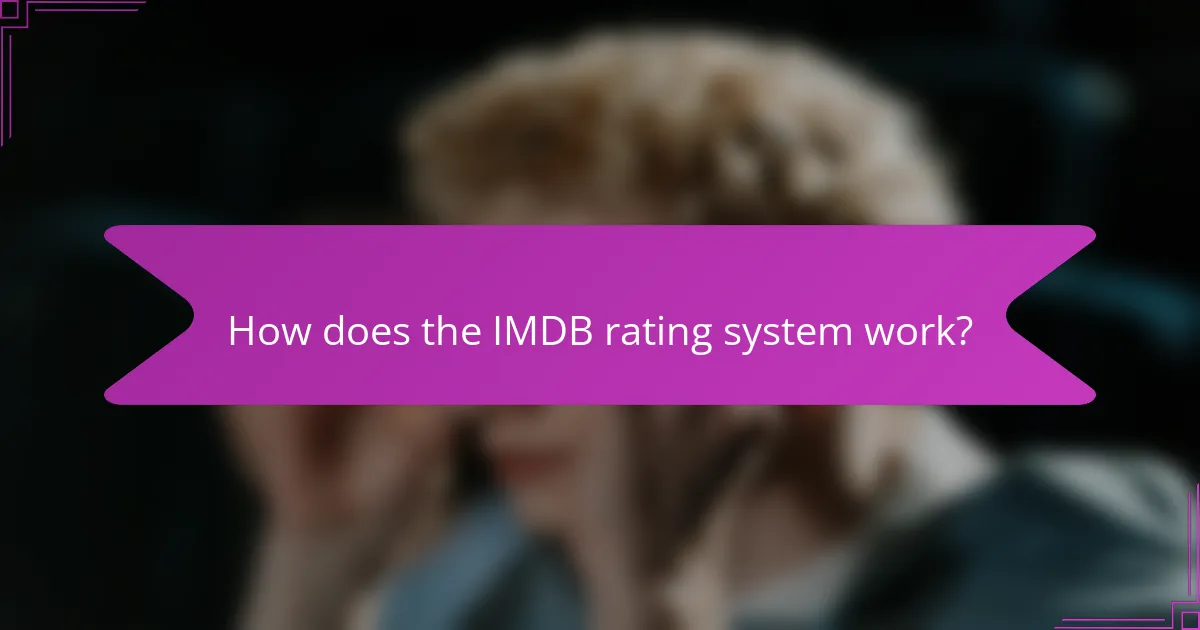The IMDB rating system is a widely recognized numerical scale that allows users to assess movies and TV shows based on their personal opinions, with scores ranging from 1 to 10. Understanding the factors that influence these ratings, such as user demographics and the volume of reviews, can help movie buffs interpret them more accurately and engage with the film community effectively.

How does the IMDB rating system work?
The IMDB rating system is a numerical scale that allows users to evaluate movies and TV shows based on their personal opinions. Ratings range from 1 to 10, with higher scores indicating better quality as perceived by the audience.
Rating scale from 1 to 10
The IMDB rating scale ranges from 1 to 10, where 1 signifies a terrible experience and 10 represents an outstanding one. Most ratings tend to cluster in the middle range, typically between 5 and 8, reflecting average to good quality films.
Users can assign any score within this scale, but it is essential to consider that a rating of 6 or 7 is often viewed as acceptable, while anything below 5 is generally seen as poor. This scale helps viewers quickly gauge the general reception of a title.
User-generated ratings
IMDB ratings are primarily user-generated, meaning that anyone with an account can submit their score. This democratic approach allows for a diverse range of opinions, but it can also lead to skewed results if a film gains a dedicated fanbase or faces backlash.
To ensure a more balanced representation, IMDB encourages users to rate films after watching them, which helps maintain the integrity of the ratings. However, users should be aware that ratings can be influenced by trends, marketing, or social media buzz.
Weighted average calculation
The IMDB rating is calculated using a weighted average formula, which gives more importance to ratings from frequent voters and established users. This method helps mitigate the impact of outlier ratings that could distort the overall score.
For example, if a movie has a high number of ratings from casual users but fewer from seasoned critics, the weighted average will adjust accordingly to reflect a more accurate consensus. This system aims to provide a fairer representation of a film’s quality over time.

What factors influence IMDB ratings?
IMDB ratings are influenced by several key factors, including the number of ratings submitted, the demographics of the users rating the film, and the quality of the reviews provided. Understanding these elements can help movie buffs interpret ratings more accurately.
Number of ratings
The total number of ratings a film receives significantly impacts its IMDB score. Generally, films with thousands of ratings tend to have more stable and reliable scores than those with only a few dozen. A higher volume of ratings can dilute the effect of extreme opinions, leading to a more balanced average.
For example, a film with 10,000 ratings may have a score that reflects a broader audience perspective compared to a lesser-known film with just 100 ratings. Therefore, when evaluating a movie’s rating, consider both the score and the number of ratings it has received.
User demographics
User demographics play a crucial role in shaping IMDB ratings. Factors such as age, gender, and location can influence how different groups perceive a film. For instance, a film may receive higher ratings from younger audiences while older viewers might rate it lower due to differing tastes.
Understanding the demographics of the raters can provide context for the rating. If a film is rated highly by a specific demographic, it may not resonate as well with others. Analyzing the demographic breakdown can help viewers gauge whether a film aligns with their own preferences.
Review quality
The quality of reviews submitted can also affect IMDB ratings. Thoughtful, detailed reviews often carry more weight than short, vague comments. High-quality reviews can provide insights into the film’s strengths and weaknesses, influencing the overall rating.
Moreover, films that receive a mix of positive and negative reviews may have a more nuanced score. It’s beneficial to read through several reviews to understand the reasoning behind ratings, as this can clarify why a film has a particular score and whether it might be worth watching based on personal taste.

How can I improve my movie’s IMDB rating?
Improving your movie’s IMDB rating involves actively engaging with viewers and encouraging positive feedback. By fostering a community around your film, you can enhance its visibility and ratings over time.
Encourage user reviews
Encouraging user reviews is crucial for boosting your movie’s IMDB rating. Ask viewers to leave their thoughts on the platform after watching your film, as positive reviews can significantly influence ratings. Consider providing incentives, such as exclusive content or merchandise, to motivate your audience to share their opinions.
Make it easy for viewers to leave reviews by providing direct links to your movie’s IMDB page on your website or social media channels. A simple call-to-action can go a long way in increasing the number of reviews.
Engage with audiences
Engaging with your audience helps build a loyal fan base that is more likely to support your film. Host Q&A sessions, live streams, or discussion forums where fans can interact with the cast and crew. This personal connection can encourage viewers to leave positive ratings and reviews.
Utilize feedback from your audience to improve future projects. Acknowledging their input shows that you value their opinions, which can lead to increased support and higher ratings on IMDB.
Promote on social media
Social media is a powerful tool for promoting your movie and improving its IMDB rating. Share behind-the-scenes content, trailers, and user-generated content to create buzz around your film. Use platforms like Instagram, Twitter, and Facebook to reach a wider audience and encourage them to watch and review your movie.
Consider running targeted ad campaigns to reach specific demographics that align with your film’s genre. Engaging visuals and compelling messages can drive traffic to your IMDB page, increasing the likelihood of receiving more reviews and higher ratings.

What are common misconceptions about IMDB ratings?
Many movie enthusiasts hold misconceptions about IMDB ratings, often misunderstanding how they are calculated and what they represent. It’s crucial to recognize that IMDB ratings are not definitive measures of a film’s quality or popularity.
All ratings are equal
A common belief is that all IMDB ratings carry the same weight, but this is not the case. Ratings can vary significantly based on the number of votes a film receives; a movie with a few hundred ratings may not be as reliable as one with thousands. Additionally, ratings can fluctuate over time as more viewers weigh in.
For example, a film with a rating of 7.0 based on 100 votes may not be as credible as another with a rating of 7.0 based on 10,000 votes. Always consider the volume of ratings when evaluating a film’s score.
Ratings reflect quality
IMDB ratings do not necessarily reflect the artistic quality of a film. They are based on user ratings, which can be influenced by factors such as marketing, audience expectations, and even social media trends. A high rating does not guarantee a film will resonate with every viewer.
For instance, a blockbuster may have a high rating due to its wide appeal, while a critically acclaimed indie film may have a lower score despite its artistic merit. It’s essential to read reviews and consider personal preferences alongside the rating.
IMDB is an official authority
IMDB is a popular database for film information, but it is not an official authority on film quality or industry standards. The ratings are generated from user votes, which can be biased or skewed. This means that while IMDB is a useful resource, it should not be the sole basis for assessing a film’s worth.
For more reliable insights, consider cross-referencing IMDB ratings with other platforms, such as Rotten Tomatoes or Metacritic, which aggregate critic reviews and provide a broader perspective on a film’s reception.

How do IMDB ratings compare to other movie rating systems?
IMDB ratings provide a unique perspective on films, focusing on user-generated scores, while other systems like Rotten Tomatoes and Metacritic offer different methodologies and criteria for evaluation. Understanding these differences can help movie buffs make informed choices about what to watch.
Rotten Tomatoes comparison
Rotten Tomatoes primarily uses a percentage-based system that reflects the proportion of positive reviews from critics and audiences. A film is considered “fresh” if it has over 60% positive reviews, while anything below that is “rotten.” This binary approach contrasts with IMDB’s 1-10 scale, which allows for more nuanced ratings.
For example, a film with a 70% rating on Rotten Tomatoes may still have a mixed reception, whereas an IMDB score of 7.0 indicates a generally favorable opinion among users. Moviegoers should consider both ratings to get a fuller picture of a film’s reception.
Metacritic analysis
Metacritic assigns a weighted average score based on reviews from critics, which can range from 0 to 100. This score is particularly useful for discerning critical consensus, as it aggregates various professional opinions into a single number. In contrast, IMDB ratings reflect the general public’s sentiment, often leading to different outcomes.
For instance, a film might receive a Metacritic score of 75, indicating generally favorable reviews, while its IMDB rating could be lower, suggesting that audience reactions are not as positive. This discrepancy highlights the importance of considering both ratings to gauge a film’s overall quality.
Audience vs. critic ratings
Audience ratings on IMDB are based on user votes, which can sometimes differ significantly from critic reviews. Critics may focus on technical aspects and artistic merit, while audiences often prioritize entertainment value and personal enjoyment. This can lead to films receiving high critic scores but lower audience ratings, or vice versa.
For example, a critically acclaimed film might have an IMDB rating of 6.5 due to mixed audience reactions, while a popular blockbuster could score an 8.0 despite receiving lukewarm reviews from critics. Movie buffs should weigh both perspectives to understand the film’s appeal and potential shortcomings.



